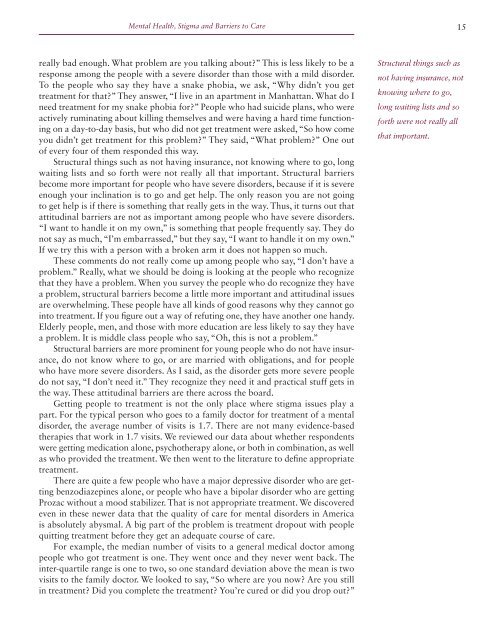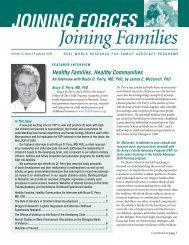stigma and barriers to care - Uniformed Services University of the ...
stigma and barriers to care - Uniformed Services University of the ...
stigma and barriers to care - Uniformed Services University of the ...
You also want an ePaper? Increase the reach of your titles
YUMPU automatically turns print PDFs into web optimized ePapers that Google loves.
Mental Health, Stigma <strong>and</strong> Barriers <strong>to</strong> Care 15<br />
really bad enough. What problem are you talking about” This is less likely <strong>to</strong> be a<br />
response among <strong>the</strong> people with a severe disorder than those with a mild disorder.<br />
To <strong>the</strong> people who say <strong>the</strong>y have a snake phobia, we ask, “Why didn’t you get<br />
treatment for that” They answer, “I live in an apartment in Manhattan. What do I<br />
need treatment for my snake phobia for” People who had suicide plans, who were<br />
actively ruminating about killing <strong>the</strong>mselves <strong>and</strong> were having a hard time functioning<br />
on a day-<strong>to</strong>-day basis, but who did not get treatment were asked, “So how come<br />
you didn’t get treatment for this problem” They said, “What problem” One out<br />
<strong>of</strong> every four <strong>of</strong> <strong>the</strong>m responded this way.<br />
Structural things such as not having insurance, not knowing where <strong>to</strong> go, long<br />
waiting lists <strong>and</strong> so forth were not really all that important. Structural <strong>barriers</strong><br />
become more important for people who have severe disorders, because if it is severe<br />
enough your inclination is <strong>to</strong> go <strong>and</strong> get help. The only reason you are not going<br />
<strong>to</strong> get help is if <strong>the</strong>re is something that really gets in <strong>the</strong> way. Thus, it turns out that<br />
attitudinal <strong>barriers</strong> are not as important among people who have severe disorders.<br />
“I want <strong>to</strong> h<strong>and</strong>le it on my own,” is something that people frequently say. They do<br />
not say as much, “I’m embarrassed,” but <strong>the</strong>y say, “I want <strong>to</strong> h<strong>and</strong>le it on my own.”<br />
If we try this with a person with a broken arm it does not happen so much.<br />
These comments do not really come up among people who say, “I don’t have a<br />
problem.” Really, what we should be doing is looking at <strong>the</strong> people who recognize<br />
that <strong>the</strong>y have a problem. When you survey <strong>the</strong> people who do recognize <strong>the</strong>y have<br />
a problem, structural <strong>barriers</strong> become a little more important <strong>and</strong> attitudinal issues<br />
are overwhelming. These people have all kinds <strong>of</strong> good reasons why <strong>the</strong>y cannot go<br />
in<strong>to</strong> treatment. If you figure out a way <strong>of</strong> refuting one, <strong>the</strong>y have ano<strong>the</strong>r one h<strong>and</strong>y.<br />
Elderly people, men, <strong>and</strong> those with more education are less likely <strong>to</strong> say <strong>the</strong>y have<br />
a problem. It is middle class people who say, “Oh, this is not a problem.”<br />
Structural <strong>barriers</strong> are more prominent for young people who do not have insurance,<br />
do not know where <strong>to</strong> go, or are married with obligations, <strong>and</strong> for people<br />
who have more severe disorders. As I said, as <strong>the</strong> disorder gets more severe people<br />
do not say, “I don’t need it.” They recognize <strong>the</strong>y need it <strong>and</strong> practical stuff gets in<br />
<strong>the</strong> way. These attitudinal <strong>barriers</strong> are <strong>the</strong>re across <strong>the</strong> board.<br />
Getting people <strong>to</strong> treatment is not <strong>the</strong> only place where <strong>stigma</strong> issues play a<br />
part. For <strong>the</strong> typical person who goes <strong>to</strong> a family doc<strong>to</strong>r for treatment <strong>of</strong> a mental<br />
disorder, <strong>the</strong> average number <strong>of</strong> visits is 1.7. There are not many evidence-based<br />
<strong>the</strong>rapies that work in 1.7 visits. We reviewed our data about whe<strong>the</strong>r respondents<br />
were getting medication alone, psycho<strong>the</strong>rapy alone, or both in combination, as well<br />
as who provided <strong>the</strong> treatment. We <strong>the</strong>n went <strong>to</strong> <strong>the</strong> literature <strong>to</strong> define appropriate<br />
treatment.<br />
There are quite a few people who have a major depressive disorder who are getting<br />
benzodiazepines alone, or people who have a bipolar disorder who are getting<br />
Prozac without a mood stabilizer. That is not appropriate treatment. We discovered<br />
even in <strong>the</strong>se newer data that <strong>the</strong> quality <strong>of</strong> <strong>care</strong> for mental disorders in America<br />
is absolutely abysmal. A big part <strong>of</strong> <strong>the</strong> problem is treatment dropout with people<br />
quitting treatment before <strong>the</strong>y get an adequate course <strong>of</strong> <strong>care</strong>.<br />
For example, <strong>the</strong> median number <strong>of</strong> visits <strong>to</strong> a general medical doc<strong>to</strong>r among<br />
people who got treatment is one. They went once <strong>and</strong> <strong>the</strong>y never went back. The<br />
inter-quartile range is one <strong>to</strong> two, so one st<strong>and</strong>ard deviation above <strong>the</strong> mean is two<br />
visits <strong>to</strong> <strong>the</strong> family doc<strong>to</strong>r. We looked <strong>to</strong> say, “So where are you now Are you still<br />
in treatment Did you complete <strong>the</strong> treatment You’re cured or did you drop out”<br />
Structural things such as<br />
not having insurance, not<br />
knowing where <strong>to</strong> go,<br />
long waiting lists <strong>and</strong> so<br />
forth were not really all<br />
that important.




